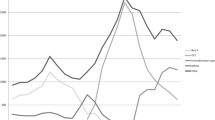Abstract
This study aims to identify the changing trends of different surgical types for female stress urinary incontinence (SUI) and the distribution amongst various providers’ characteristics. A total of 17,532 women who had undergone surgery for SUI during 1996–2005 were identified from the National Health Insurance Research Database for analysis. Retropubic urethropexy (RPU) was the most common surgical type (43%), followed by tension-free mid-urethral sling (MUS; 24%), and traditional pubovaginal sling (15%). MUS had an annual growth rate of 20.5%, whilst traditional pubovaginal sling was reduced by 11.3% annually after 2002. RPU was the most common procedure by both gynecologists and urologists. Gynecologists performed more Kelly plications, whereas urologists performed more traditional pubovaginal sling. MUS was more commonly performed in medical centers than in regional and local hospitals. There has been a notable growth and changing trend in various surgical types for female SUI in Taiwan.

Similar content being viewed by others
References
Abram P, Andersson KE, Brubaker L, Cardozo L, Cottenden A, Denis L et al (2005) Recommendations of the International Scientific Committee: evaluation and treatment of urinary incontinence, pelvic organ prolapse and faecal incontinence. 3rd International Consultation on Incontinence:1589–1630
Yu HJ, Wong WY, Chen J, Chie WC (2003) Quality of life impact and treatment seeking of Chinese women with urinary incontinence. Qual Life Res 12:327–333
Chen GD, Lin TL, Hu SW, Chen YC, Lin LY (2003) Prevalence and correlation of urinary incontinence and overactive bladder in Taiwanese women. Neurourol Urodyn 22:109–117
Rovner ES, Wein AJ (2004) Treatment options for stress urinary incontinence. Rev Urol 6(Suppl 3):S29–S47
Burch JC (1961) Urethrovaginal fixation to Cooper’s ligament for correction of stress incontinence, cystocele, and prolapse. Am J Obstet Gynecol 81:281–290
Schick E, Jolivet-Tremblay M, Tessier J, Dupont C, Bertrand PE (2004) Observations on the function of the female urethra: III: an overview with special reference to the relation between urethral hypermobility and urethral incompetence. Neurourol Urodyn 23:22–26
Raz S, Stothers L, Young GP, Short J, Marks B, Chopra A et al (1996) Vaginal wall sling for anatomical incontinence and intrinsic sphincter dysfunction: efficacy and outcome analysis. J Urol 156:166–170
Ulmsten U, Petros P (1995) Intravaginal slingplasty (IVS): an ambulatory surgical procedure for treatment of female urinary incontinence. Scand J Urol Nephrol 29:75–82
de Leval J (2003) Novel surgical technique for the treatment of female stress urinary incontinence: transobturator vaginal tape inside-out. Eur Urol 44:724–730
Ulmsten U, Henriksson L, Johnson P, Varhos G (1996) An ambulatory surgical procedure under local anesthesia for treatment of female urinary incontinence. Int Urogynecol J Pelvic Floor Dysfunct 7:81–85 discussion 85–86
Wang AC, Lo TS (1998) Tension-free vaginal tape. a minimally invasive solution to stress urinary incontinence in women. J Reprod Med 43:429–434
Nilsson CG, Kuuva N, Falconer C, Rezapour M, Ulmsten U (2001) Long-term results of the tension-free vaginal tape (TVT) procedure for surgical treatment of female stress urinary incontinence. Int Urogynecol J Pelvic Floor Dysfunct 12(Suppl 2):S5–S8
Department of Health, Health and National Health Insurance Annual Statistics Information Services. http://www.doh.gov.tw/statistic/index.htm
Lapitan MC, Cody DJ, Grant AM (2005) Open retropubic colposuspension for urinary incontinence in women. Cochrane Database Syst Rev:CD002912
Balmforth J, Cardozo LD (2003) Trends toward less invasive treatment of female stress urinary incontinence. Urology 62:52–60
Albo ME, Richter HE, Brubaker L, Norton P, Kraus SR, Zimmern PE et al (2007) Burch colposuspension versus fascial sling to reduce urinary stress incontinence. N Engl J Med 356:2143–2155
Minassian VA, Al-Badr A, Drutz HP, Lovatsis D (2004) Tension-free vaginal tape, Burch, and slings: are there predictors for early postoperative voiding dysfunction? Int Urogynecol J Pelvic Floor Dysfunct 15:183–187
Bezerra CA, Bruschini H (2001) Suburethral sling operations for urinary incontinence in women. Cochrane Database Syst Rev:CD001754
Nilsson CG, Falconer C, Rezapour M (2004) Seven-year follow-up of the tension-free vaginal tape procedure for treatment of urinary incontinence. Obstet Gynecol 104:1259–1262
Kondo A, Isobe Y, Kimura K, Kamihira O, Matsuura O, Gotoh M et al (2006) Efficacy, safety and hospital costs of tension-free vaginal tape and pubovaginal sling in the surgical treatment of stress incontinence. J Obstet Gynaecol Res 32:539–544
Lim MY, Perera M, Ramsay I, Tierney J, Hardwick C (2007) Surgical management of stress urinary incontinence in Scotland and Wales: a questionnaire study. Int J Surg 5:162–166
Davila GW, Ghoniem GM, Kapoor DS, Contreras-Ortiz O (2002) Pelvic floor dysfunction management practice patterns: a survey of members of the International Urogynecological Association. Int Urogynecol J Pelvic Floor Dysfunct 13:319–325
Novara G, Ficarra V, Boscolo-Berto R, Secco S, Cavalleri S, Artibani W (2007) Tension-free midurethral slings in the treatment of female stress urinary incontinence: a systematic review and meta-analysis of randomized controlled trials of effectiveness. Eur Urol 53:288–308
Surgical treatment of urodynamic stress incontinence. Royal College of Obstetricians and Gynecologists Guideline No. 5:1–9
Hunskaar S, Lose G, Sykes D, Voss S (2004) The prevalence of urinary incontinence in women in four European countries. BJU Int 93:324–330
Tseng IJ, Chen YT, Chen MT, Kou HY, Tseng SF (2000) Prevalence of urinary incontinence and intention to seek treatment in the elderly. J Formos Med Assoc 99:753–758
Diokno AC, Sand PK, Macdiarmid S, Shah R, Armstrong RB (2006) Perceptions and behaviours of women with bladder control problems. Fam Pract 23:568–577
Griffiths JM, Black NA, Pope C, Stanley J, Bowling A, Abel PD (1998) What determines the choice of procedure in stress incontinence surgery? The use of multilevel modeling. Int J Technol Assess Health Care 14:431–445
Tension-free vaginal tape (TVT) procedure. Int J Gynaecol Obstet 91:279–282
Acknowledgments
The authors are grateful for the financial support provided by Chi Mei Foundation Hospital, Taiwan (94CM-KMU-03 and 96CM-KMU-05).
Conflicts of interest
None.
Author information
Authors and Affiliations
Corresponding authors
Rights and permissions
About this article
Cite this article
Wu, MP., Huang, KH., Long, CY. et al. The distribution of different surgical types for female stress urinary incontinence among patients’ age, surgeons’ specialties and hospital accreditations in Taiwan: a descriptive 10-year nationwide study. Int Urogynecol J 19, 1639–1646 (2008). https://doi.org/10.1007/s00192-008-0697-5
Received:
Accepted:
Published:
Issue Date:
DOI: https://doi.org/10.1007/s00192-008-0697-5




